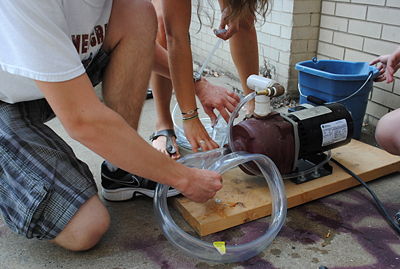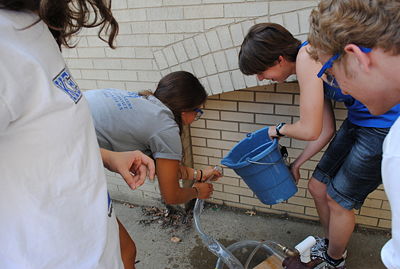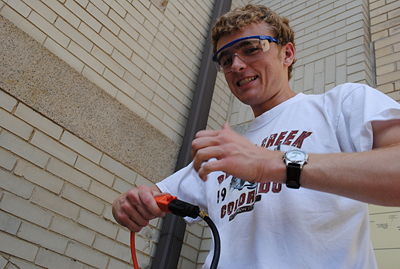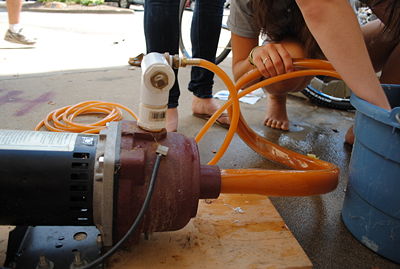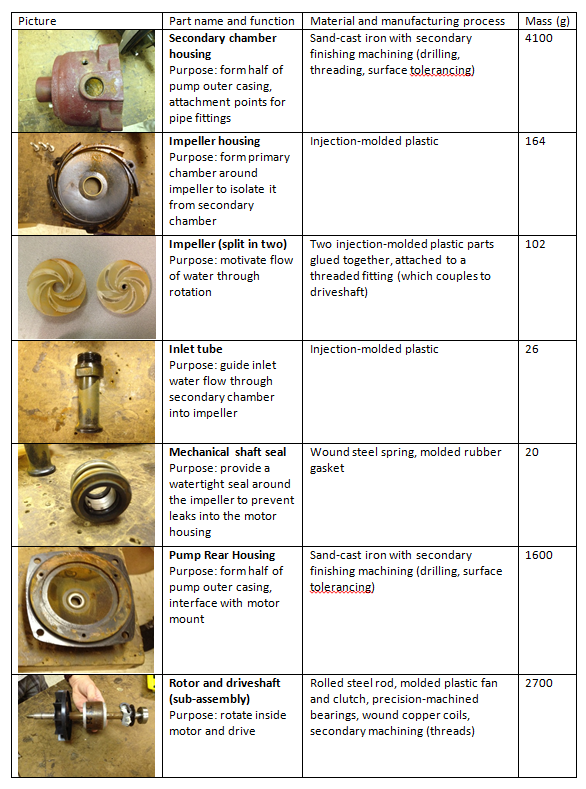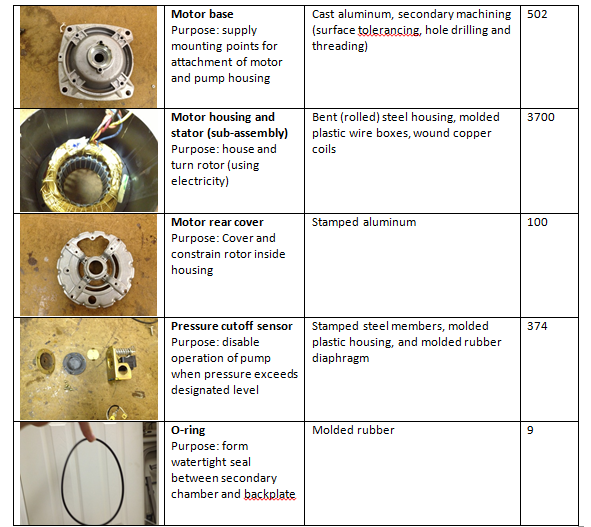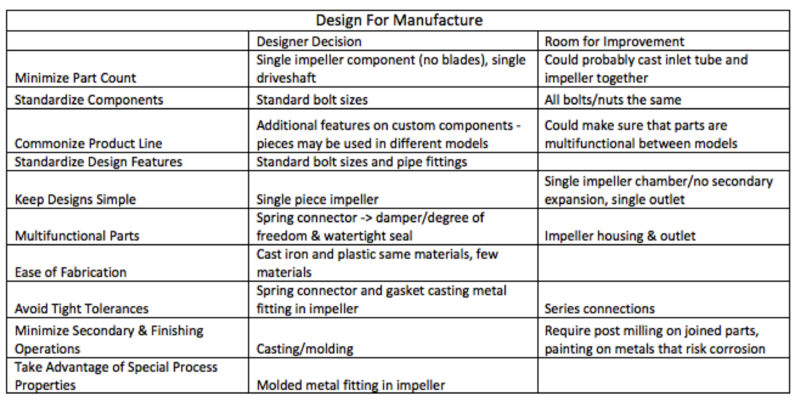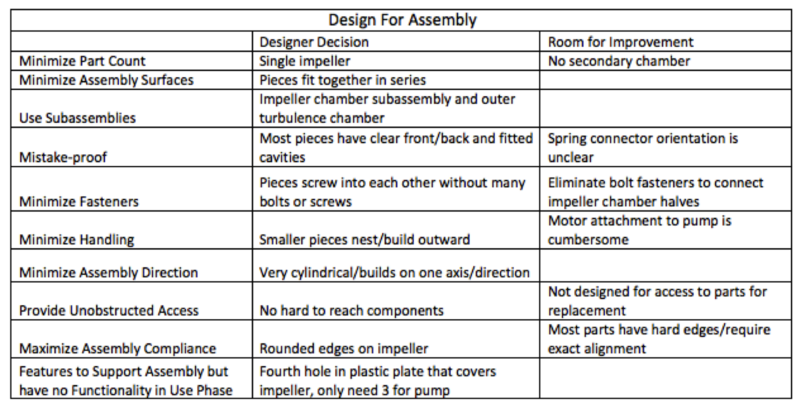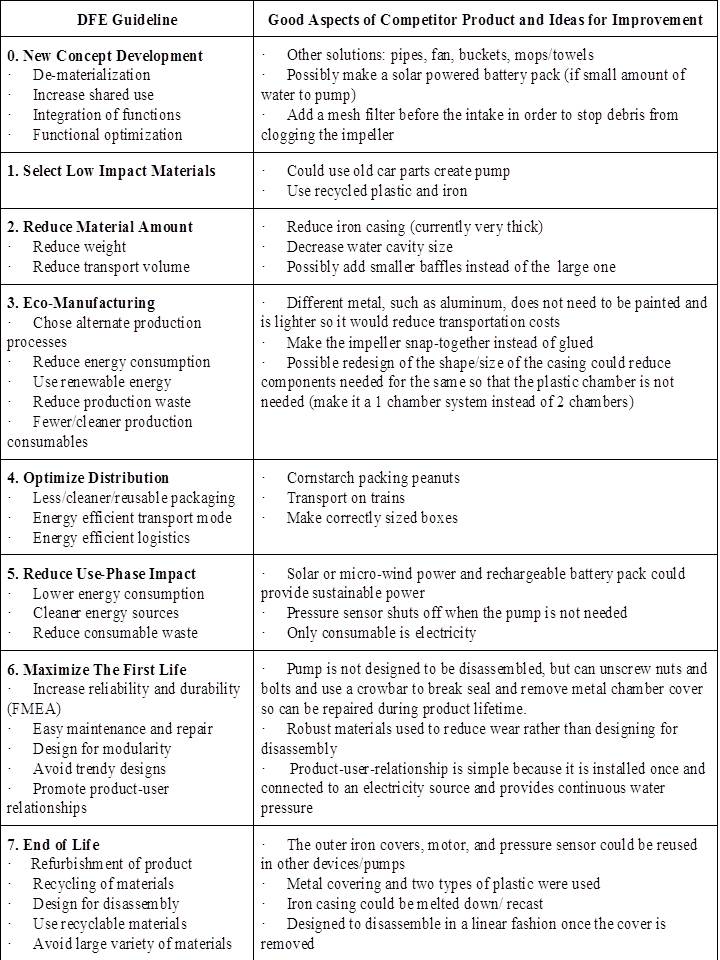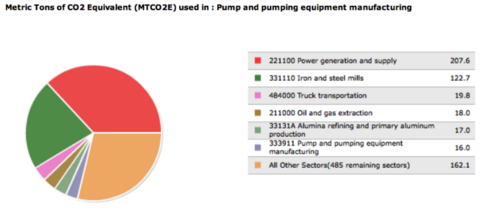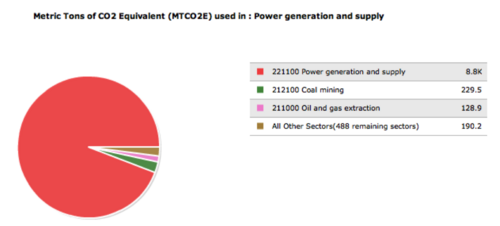Water pump
From DDL Wiki
Contents |
Executive Summary
A shallow well jet pump is a centrifugal water pump used for pumping water from shallow wells for residential use in areas with access to electricity but not municipal water sources. A GE Motors and Industrial Systems (model # 5KH39HN3528CX) water pump has been dissected and analyzed for better understanding of its function, parts and properties. The dissection provided insight into how the part was manufactured, enabling us to determine how the part was Designed for Manufacture, Designed for Assembly, and Designed for Environment. A Failure Mode and Effects Analysis and a Life Cycle Analysis were performed.
The pump was designed with a single impeller and standard bolt sizes and pipe fittings for simpler manufacture. The parts assemble in series and most parts have an obvious front/back for simpler assembly. Some improvements could be made in using materials that don’t require paint to prevent corrosion, eliminate bolt fasteners to connect impeller chamber halves, and streamline the nuts and bolts.
We determined that this pump is fairly environmentally friendly, but suggest that the iron casing be reduced in size, possible redesign to eliminate the need for separate parts delineating two unique chambers, and use with solar panels and a larger holding tank to eliminate electricity associated GHC emissions. These recommendations are based both on inspection and on the results of the EIO-LCA model, which indicated that the most significant contributors to GHG emissions are power generation and supply, iron and steel mills, and truck transportation.
In the FMEA analysis, it was determined that the components with the highest failure effect were the motor, inlet tube and mechanical shaft seal, failing due to material fatigue and improper pump use. These failures can be reduced by by redesigning with tighter tolerances, an inlet water filter and making heavily used components easy to replace.
Primary Stakeholders and Product Needs
The major stakeholders are the customer and the producer/shipper, a secondary stakeholder is the plumber or related professional who installs the pump in a well-house. Shallow-well jet pumps such as ours are typically used to draw water for household use in rural homes with a high water table. The pump must be durable and mechanically robust so that it can run reliably after installation with minimal maintenance. Although some form of shelter from the elements is typically provided, the pump needs to withstand cyclic heating/cooling and damp or dry conditions. The shipper needs the product to be as light and small as possible to reduce fuel costs for shipping (a major component of associated GHG emissions). The installation professional requires that the pump be easy to orient and stabilize, and simple to install with standard fittings. These three stakeholders define the major product development constraints.
Product Use
1. Attach inlet and outlet pipes - In typical use, the T-fitting will lead to a holding/pressure/storage tank and to the household plumbing.
2. Ensure all pipes and pump are filled with water
3. Plug the motor into electrical outlet or wire to breaker panel
4. The pump will automatically run until the pressure set in the sensor is met or it runs out of water
How the Product Functions Mechanically
First plug in the motor with the appropriate voltage selected. The electricity runs through the pressure sensor and then to the motor. The motor turns an internal shaft which is connected to a buffer spring. The spring is connected to the impeller which is connected to an nozzle that goes to the inlet. So the motor shaft, spring, impeller, and nozzle are all connected into one shaft driven by the motor.
When the motor turns it creates a suction which draws the water through the inlet and nozzle to the impeller. The spinning impeller then throws the water out into the iron chamber causing a vortex to develop. This vortex then causes the pressure to increase inside the iron chamber and forces the water through the outlet. It is the pressure created from the spinning water that is actually pumping the water.
The pressure sensor is connected to the iron chamber and when the pressure reaches a certain threshold, it causes a mechanical switch to cut the power to the motor. The pressure sensor threshold can be adjusted by setting a spring to a predetermined compression. Then when the pressure increases it compresses the spring more, which will cause the circuit to break through various mechanical linkages.
Bill of Materials
Design for Manufacture and Assembly (DFMA)
Design for Manufacture
The pump features a simple design with a single impeller, which enables the pump to accomplish the task at hand in the least number of parts for simplest manufacture. Cast iron and plastic are the primary materials in the device, as use of fancy materials is not necessary for the pump. The table below outlines in more detail the designers’ decisions to make the manufacturing process simpler, and areas where the process could be improved.
Design for Assembly
The parts of the pump assemble in series, and most pieces screw into each other with excess fasteners. The components have obvious front/backs for easier assembly. Standard bolt sizes and pipe fittings are a wise choice because it eliminates any need to acquire specialized fasteners. The table below outlines in more detail the designers’ decisions to make the assembly process simpler, and areas where the process could be improved.
Failure Mode and Effects Analysis (FMEA)
FMEA was done by scoring major components on basis of (S)everity, (O)currence and (D)etectibility. These values are multiplied to determine a Risk Priority Number,which allows the failure effects of each component to be compared.
Because of the number and complexity of system components, a typical single-stage, mechanically coupled centrifugal pump can fail in approximately 600 ways (Mechanisms). To narrow pump failure modes to the most likely component failures, it was assumed that the most likely causes of pump failure would take place in the moving parts of the system, located along the shaft. The stationary components were assumed to be less susceptible to fatigue and stress failure, unless noted in the dissection and use study as in the case of the inlet nozzle and pump casing.
The inlet nozzle, the motor, the pressure switch and the mechanical shaft seal were determined to have the highest combined RPN value. The inlet nozzle is crucial for pump function and was observed to fail under long term use. The motor is the most complicated assembly and can be dangerous if it fails due to overheating or if water leaks in. The mechanical shaft seal both have multiple modes of failure and can easily become fatigued or broken with pump misuse.
It was noted during the dissection and use study that the tip of the inlet nozzle was broken off inside the housing, indicating fatigue as a mechanism of failure for the nozzle. The inside of the pump housing chamber was extremely rusted and the water circulated through the pump became contaminated, which is a system failure for intended use as a well pump.
To prevent overall component failure, it is most important to properly assemble the pump and have narrow tolerances, particularly on the shaft components because a misaligned component will be subjected to high stresses and causes vibrations in the system. It is also important to prime the pump before use because mechanical seals will overheat and permanently fail due to increased friction. Debris in the water is a cause of multi-component failure because an occlusion in any part of the pump will result in high system pressure. The addition of a filter and rust-prevention measures, such as internal coating or an easy way to empty the pump of water would be beneficial to include in redesign. It would also be beneficial to redesign the pump such that it is easy to disassemble and replace fatigable parts, such as the shaft seal. However there are trade-offs because the addition of these design changes would increase system cost.
| Item and Function | Failure Mode | Effects of Failure | S | Causes of Failure | O | Design Controls | D | RPN | Recommended Actions |
|---|---|---|---|---|---|---|---|---|---|
| Mechanical Shaft Seal: water tight coupler from output shaft to impeller | Rubber overheats or fatigues | Seal is broken, fluid leaks into motor, pump stops working | 8 | Heat generated by increased friction (dry running pump or running pump beyond limits) | 4 | Pressure Sensor prevents pump operation under high pressures | 3 | 96 | Prime pump before use |
| Mechanical Shaft Seal | Spring Fatigue | Seal is broken, fluid leaks into motor, pump stops working | 8 | Increased torque on spring (pump running beyond limits); Increased system vibrations (worn bearings, misaligned shaft components) | 2 | Pressure Sensor prevents pump operation under high pressures | 3 | 48 | Replace mechanical seal periodically; Decrease assembly tolerances |
| Impeller:Centrifugally accelerates water | Plastic deforms | Flow rates decrease or stop; Pump vibrations increase due to unbalances rotation | 8 | High pressure; high liquid temperatures; becomes occluded by debris | 1 | Pressure Sensor cuts power to motor if pressure exceeds limit | 3 | 24 | Filter water at inlet; decrease assembly tolerances |
| Inlet Nozzle: Delivers water to impeller | Fatigue weakens | Pump cannot circulate water | 4 | tip breaks due to fatigue and vibrations; Increased back pressure due to debris occlusion | 3 | Pump can be bolted down to reduce mechanical vibrations | 9 | 108 | Securely bolt down pump before use; filter water before inlet |
| Iron Housing: circulates pressurized water to outlet | Rust | Contaminates water | 3 | Material rusts over time | 8 | n/a | 1 | 24 | Coat inner chamber to prevent rust; Empty housing when not in use |
| Motor: generates torque for impeller rotation | Metal fatigue of bearings | Increased rotational friction on motor shaft overheats motor, possibly stopping pump | 7 | Improper assembly resulting in high bearing stress and high system vibration | 2 | Switch on shaft that cuts electricity to motor under high shaft stress | 9 | 126 | Decrease assembly tolerances; Use robust bearings |
| Pressure Switch: cut motor circuit at set pressure limit | Diaphragm Seal rubber stiffens or ruptures | Inaccurate pressure input to pressure switch; water leakage to electrical components | 2 | Aged rubber; Rust deposits corrode rubber | 2 | Diaphragm is replaceable | 3 | 12 | Prevent rust by coating inner chamber; Replace seal periodically |
| Pressure Switch | Inlet tube becomes occluded | Pump doesn't respond to changes in water pressure | 2 | Debris in water | 2 | n/a | 9 | 36 | Filter water before inlet |
| Pressure Switch | Springs Fatigue | Switch becomes uncalibrated; Pump doesn't shut off under high pressures or switch is permanently in "off" position | 3 | Switch Fatigue (if pump is improperly run and switch repeatedly activates) | 3 | If undamaged, spring can be re calibrated by tightening nut | 6 | 54 | Run pump consistently within limits |
Design For Environment (DFE)
The DFE analysis showed that the pump system can easily be recycled and does not waste many materials. The motor and pressure sensor do not appear to be specifically designed for this system and so they could potentially be used in other products. The pump’s iron casing can be recast and the plastic parts can be recycled. The entire system was not built to be disassembled because it is difficult to take apart and a seal has to be broken in order to fix any internal parts. The chosen materials are robust, therefore it seems that it was meant to last a long time without failure, but not be fixed after breaking. There are several suggestions for improving the design. Possibly make the pump solar powered or have a battery pack that could be charged using solar power. The iron casing could be made thinner as the current component could withstand extraordinary pressures. Also instead of using iron, aluminum would still be strong enough and since its lighter, would cut down on shipping costs. The pump could be redesigned to only have one chamber, which would cut down on materials, assembly time, and shipping costs.
EIO-LCA
The pump we dissected is no longer on the market. However similar pumps cost approximately $200.00 - $300.00 and have an average warranty of 1-3 years.
Great River Energy, a Minnesota and Wisconsin Energy Cooperative, estimates that farm house well pumps draw between 7 and 108 kwh/month. Since a half-horsepower shallow-well pump is at the low end of the power spectrum, we assume that the average power use is under 10kwh/month. The year to date national average residential electricity cost per kwh is $0.1179 as of June 2012 according to the US Energy Information Administration. From this, we estimate the total energy use cost of this pump over a conservative lifetime of 3 years to be $42.44.
When the pump is installed, it is necessary to dig a well, install a holding/pressure tank and plumb the associated farmhouse. However, these expenses are not dependent on the type of pump used and are therefore neglected in this analysis. The pump is drawing ground water from the land of the pump owner, so there are no significant ongoing costs during the lifetime of the pump.
The two main industries the pump falls into are therefore “Pump and Pumping Equipment Manufacturing” (Sector # 333911) and “Power Generation and Supply” (Sector # 221100).
Using the EIO-LCA analysis tool we found that 530 Tons of CO2 are generated per million dollars of goods purchased in sector 333911 and 9370 Tons of CO2 are generated per million dollars spent in sector 221100. With our inputs of about $300.00 and $42.44 respectively, that amounts to CO2 outputs of 0.159 Tons and 0.398 Tons respectively. This ratio of production emissions to use emissions is relatively high for electricity intensive appliances and indicates that increasing the pump’s useful lifetime and improving the efficiency of production could produce a significant percent reduction in the CO2 emissions associated with the lifecycle of the product.
A $30.00 / Ton tax on CO2 emissions would increase the purchase price by 4.77 and the use-cost by 11.92 over three years for a product lifetime cost increase of $16.70 or 4.9%. This is not expected to have a significant impact on consumer choices, although a carbon tax could produce a general consumer trend towards more energy efficient appliances.
Since a carbon tax would raise electricity prices significantly, consumers may justify purchasing more efficient appliances across the board, but the increased use-cost of this pump is actually not that large.
For the production section of the pump lifecycle, the primary contributing sectors to GHG emissions are Power Generation and Supply, Iron and steel Mills, and Truck Transportation, which are all indirect emissions sources. Pump and pumping equipment manufacturing is only the sixth highest contributor to GHG emissions with 13.4 tons CO2 emitted per million dollars purchaser input.
In contrast, during the pump’s use the vast majority of GHG emissions are directly from power generation and supply, the sector that provides electricity to run the pump.
The two selected economic input sectors are assumed to be a very good representation of the costs associated with our product because both are narrow (do not represent significant aggregation uncertainty) and effectively describe the product and lifetime use-input. In both power generation and supply, and pump and pumping equipment manufacturing, the product falls in at least half of the sub-sectors of the aggregate sector.
Team
Team Leader: Jerry
DFMA Leader: Kyra
FMEA Leader: Jenny
DFE Leader: Christina
Life Cycle Analysis Leader: Eva
The use study and dissection were collaborative as well as the slide presentation, executive summary and conclusion articles. Christina wrote the stakeholders article, how the system functions mechanically section, part of the DFE summary and DFE table. Kyra wrote the step-by-step instructions, DFMA summary and the DFMA table. Jerry wrote the bill of materials and labeled the components. Eva added, cropped and labeled the product pictures, conducted the life cycle analysis, and wrote part of the DFE summary. Jenny took the product pictures, wrote the FMEA summary and the FMEA table. To coordinate with each other, we met frequently and used google.docs to compile the final report. The process started with researching pumps, how they work and their uses. We then conducted a use study, then the dissection, division of the various engineering tables/guidelines, wrote the slides, and compiled the report.
References
List of 600+ Mechanisms of Pump Failure. http://www.lifetime-reliability.com/free-articles/reliability-improvement/pump-failure-modes-list.html
How to Adjust Water Pump Pressure Control Switch. http://inspectapedia.com/water/WaterPumpAdjust.htm
Mechanical Shaft Seals for Pumps: http://net.grundfos.com/doc/webnet/waterutility/_assets/downloads/shaft_seals.pdf
Electric Motor Failure Modes. http://blog.machineryhealthcare.com/bid/47114/Electric-motor-failure-modes
Household Uses: http://www.plumbers-inpittsburgh.com/uses-of-a-water-pump-that-you-should-to-know
LCA: http://www.eiolca.net http://www.greatriverenergy.com/aboutus/pressroom/doc101349.pdf http://www.eia.gov
